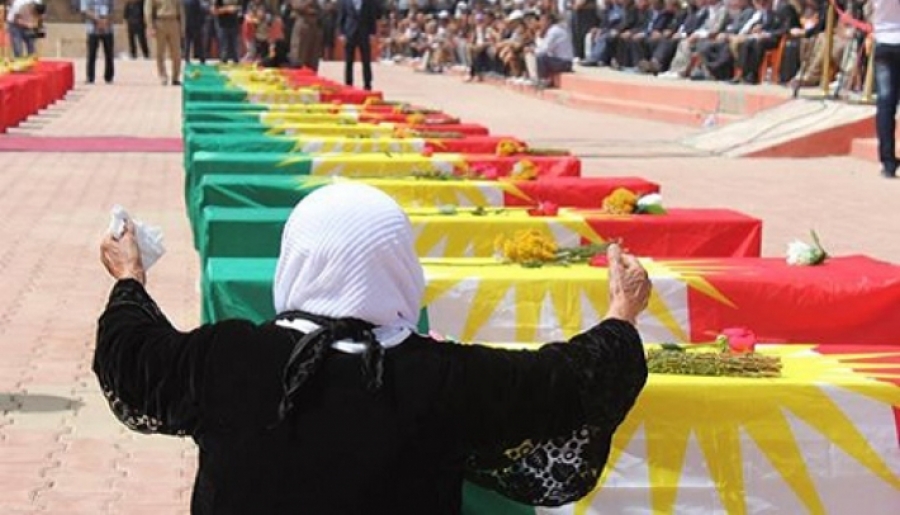Anfal
Kurdistan's Darkest Hour

Reporter Chris Carr has turned from the open freedom of the youth conference to focus on Kurdistan, a part of the world that until recently was not free at all.
روژنامهڤان كریس كار یێ زڤری ڤه ژ كونفرانسێ گهنجان یێ ڤهكرنا ئازادیێ داكو تهكهزێ (تأكید) بكهته سهر كوردستانێ ,پارچهكا جیهانێ تاكو بهرى چهندێ ب تهمامى یا ئازاد نه بو .
They say the darkest hour is the hour before dawn, and this is very true of Kurdistan. For the Kurd, the sun is now rising on a bright new day, but they will never forget their 'darkest hour'- the year of death and destruction that Saddam Hussein brought them and all of Iraq.
Before travelling to Kurdistan, I knew very little about the Anfal- Saddam genocide against the Kurd that continued from 1979 to 1988. I had planned only to write about Kurdistan's recent rapid development.
د بێژن تاریترین دهمژمێر ئهو دهمژمێره یا بهرى سحارێ, ئهڤه گهلهك راسته بو كوردستانێ ,بو كوردا,روژ نوكه یا دههلێت د روژهكا گهش و نوى دا .لێ ئهو چ جارا تاریترین دهمژمێرا خو ژ بیر ناكهن , سالێن مرنێ و تالان كرنێ ئهوێن صدام حسێن ئینایینهسهرێ وان و ههمى عیراقێ .
بهرى گهشتێ بكهم بو كوردستانێ , من گهلهك كێم دزانى دهربارهى ئهنفالێ, كومكوژیا صدامى بهرامبهر كوردان ئهوا بهردهوام بوى ژ 1979 تاكو 1988 . پلانا من بتنێ ئهو بو كو ل سهر پێشكهفتنا ب لهزا ڤێ دوماهیێ یا كوردستانێ بنڤێسم.
On arriving in Erbil, my good friend, museum director Dr. Haval Sherzad, kindly invited me to his home for dinner. While eating, we talked about the long history of the Kurdish people. I learned that they had always suffered war and persecution. 'But' Dr. Haval went on, the worst persecution of all happened in very recent time.' I asked him to tell me more. He asked whether I really wanted to hear about it, and I immediately said I did. 'Well' he began, it' hard to talk about it. But I will, because you should know. Everyone should. And you can help us, too, if you write about the Anfal in your newspaper.' I promised that I would
ل دهمێ گههشتنێ بو ههڤلێرێ , هڤالێ من یێ باش , رێڤهبهرێ موزهخانێ د. ههڤال شێرزاد , ب دلهكێ بهرفرههڤه ئهز داخاز كرمه مالا خو بو شیڤ خارنێ . دهمێ مه خارن دخار , مه د ئاخفت دهربارهى مێژویا درێژا كوردان . من زانى كو ئهوان ههمى دهما نه خوشى و بن دهستى یا دیتى. لێ د. ههڤال بهردهوام بو خراپترین بندهستى یا مه دیتى یا چێبوى د دهمهكێ دا لڤێ دوماهیێ . من داخاز ژ وى كر كو هێشتا بو من بێژیت . ئهوى پرسیار ژ من كر كانێ من ژ راست دڤێت گوهدار بم , و من دهم ل دهست گوتێ بهلێ من دڤێت مو گولێ بیت . ئهوى دهست پێكر "یا بزهحمهته مروڤ دهربارهى ڤێ چهندێ باخڤیت , لێ ئهز دێ ئاخڤم چونكى پێت ڤیه تو بزانى , پێتڤیه هه مى كهس بزانن . و تو ههروهسا دشیێ هاریكاریا مه بكهى , ئهگهر ته دهربارهى ئهنفالێ بنڤێسى د روژناما خو دا. من سوز دا وى كو ئهز دێ نڤێسم .
Then I listened as my friend quietly told me about atrocity after atrocity under Saddam's cruel Government. I was horrified. First, in 1979-80, hundreds of thousands of Kurds in Arab areas simply disappeared. Then, in 1983, villages in Kurdistan were destroyed and 8,000Barzanies were buried alive. In 1987 and 1988, Saddam used horrific chemical weapons, first on Shekh Wassanan and Balisan and then on Halabja. In those same years there were also massacres in many other parts of Kurdistan. 182,000 people died and 5,000 villages were destroyed
پاشى من گوهدارى كر دهمێ ههڤالێ من بو من بهحسێ درندهى ل دویف درندهى یێ كرى. ل دهست پێكێ ل سالێن 1979 -80 ب سهدان ژ هزارههان كهسان ل دهڤهرێن عهرهبا هاتنه بهرزه كرن . پاشى , ل سالا 1983 گوند ل كوردستانێ هاتنه كاڤلكرن و 8000 بارزانى ب ساخى هاتنه ڤهشارتن .ل سالێن 1987 و 1988 سهدامى چهكێ ب ترسێ كێمیایێ ب كار ئینا , ل دهست پێكێ شێخ وهسانان و بالیسان و پاشى ل حهلهبجه . دڤان ههمان سالان دا ههروهسا كوكوژى ههبون ل گهلهك پارچێن دى یێن كوردستانێ 182,000 مروڤا گیانێ خو ژ دهست دا و 5000 گوند هاتنه كاڤلكرن .
Can all this really be true? I finally asked. Dr. Haval said nothing; instead, he went and brought back a large box. I inquired what was in the box. 'Photos' he replied. They are photos of the Anfal from all over the Kurdistan, and they are the answer to your question. They are the truth. 'He explained that the museum was collecting those photos for a permanent exhibition. It'll be the memorial to all who suffered and died, he said
ئهرێ ئهڤه ههمى راسته ؟ ل دوماهیێ من پرسیار كر . د. ههڤال چ نه گوت . ل جهێ وێ چهندێ, ئهو چوو و سنوقهكا مه زن د گهل خو ئینا . من پرسیار ژێ كر كانێ چ د وێ سندوقێ دا یه . ئهوى گوت وێنه . ئهو وێنێنن ئهنفالێ نه ل سهرانسهرى كوردستانێ , و ئهڤه بهرسڤا پرسیارا ته نه . ئهڤه راستی نه. ئهوى شروڤه كر كو موزهخانا وى وێنه كوم دكرن بو پێشانگهههكا ههرو ههر . دا ب بیته بیرهاتنهك بو وان ههمیا یێن نه خوشى برین و گیانێ خو ژ دهست داى .
After letting me look at the terrible pictures for several minutes, he quietly said, if the world sees what really happened, and then maybe, just maybe, human will learns never again to do these terrible things to each other.
پشتى كو ئهوى هێلاى ئهز سهحكهمه وان وێنێن ب ترس بو چهند خولهكهكا , ئهوى ب هێمنى ڤه گوت , ئهگهر جیهان ب بینیت كانێ ب دروستى چ چێ بویه , دبیت , بهلكى دبیت, مروڤ فێر ب بن كو چ چارێن دى ڤان تشتێن خراب گهل ئێكو دو نوكهنهڤه.
 ئەکادیمیا قوتابی
ئەکادیمیا قوتابی